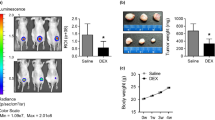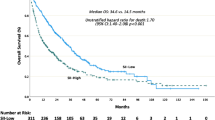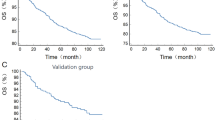Abstract
Nitric oxide (NO) is an important molecule in regulating tumour blood flow and stimulating tumour angiogenesis. Inhibition of NO synthase by L-NAME might induce an anti-tumour effect by limiting nutrients and oxygen to reach tumour tissue or affecting vascular growth. The anti-tumour effect of L-NAME after systemic administration was studied in a renal subcapsular CC531 adenocarcinoma model in rats. Moreover, regional administration of L-NAME, in combination with TNF and melphalan, was studied in an isolated limb perfusion (ILP) model using BN175 soft-tissue sarcomas. Systemic treatment with L-NAME inhibited growth of adenocarcinoma significantly but was accompanied by impaired renal function. In ILP, reduced tumour growth was observed when L-NAME was used alone. In combination with TNF or melphalan, L-NAME increased response rates significantly compared to perfusions without L-NAME (0–64% and 0–63% respectively). An additional anti-tumour effect was demonstrated when L-NAME was added to the synergistic combination of melphalan and TNF (responses increased from 70 to 100%). Inhibition of NO synthase reduces tumour growth both after systemic and regional (ILP) treatment. A synergistic anti-tumour effect of L-NAME is observed in combination with melphalan and/or TNF using ILP. These results indicate a possible role of L-NAME for the treatment of solid tumours in a systemic or regional setting. © 2000 Cancer Research Campaign
Similar content being viewed by others
Article PDF
Change history
16 November 2011
This paper was modified 12 months after initial publication to switch to Creative Commons licence terms, as noted at publication
References
Ambs S, Merriam WG, Bennett WP, Felley-Bosco E, Ogunfusika MO, Oser SM, Klein S, Shields PG, Billiar TR and Harris CC (1998) Frequent nitric oxide synthase-2 expression in human colon adenomas: implications for tumour angiogenesis and colon cancer progression. Cancer Res 58: 334–341
Andrade SP, Hart IR and Piper PJ (1992) Inhibitors of nitric oxide synthase selectively reduce flow in tumour-associated neovasculature. Br J Pharmacol 107: 1092–1095
Buttery LDK, Springall DR, Andrade SP, Riveros-Moreno V, Hart I, Piper PJ and Polak JM (1993) Induction of nitric oxide synthase in the neo-vasculature of experimental tumours in mice. J Pathol 171: 311–319
de Wilt JHW, Manusama ER, van Tiel ST, van IJken MGA, ten Hagen TLM and Eggermont AMM (1999) Prerequisites for effective isolated limb perfusion using tumour necrosis factor alpha and melphalan in rats. Br J Cancer 80: 161–166
de Wilt JHW, ten Hagen TLM, de Boeck G, van Tiel ST, de Bruijn EA and Eggermont AMM (2000) Tumour necrosis factor alpha increases melphalan concentration in tumour tissue after isolated limb perfusion. Br J Cancer 82: 1000–1003
Eggermont AMM, Schraffordt Koops H, Liénard D, Kroon BBR, van Geel AN, Hoekstra HJ and Lejeune FJ (1996a) Isolated limb perfusion with high-dose tumor necrosis factor-α in combination with interferon-γ and melphalan for nonresectable extremity soft tissue sarcomas: a multicenter trial. J Clin Oncol 14: 2653–2665
Eggermont AMM, Schraffordt Koops H, Klausner J, Kroon BBR, Schlag PM, Liénard D, van Geel AN, Hoekstra HJ, Meller I, Nieweg OE, Kettelhack C, Ben-Ari G, Pector JC and Lejeune FJ (1996b) Isolated limb perfusion with tumor necrosis factor and melphalan for limb salvage in 186 patients with locally advanced soft tissue extremity sarcomas: the cumulative multicenter european experience. Ann Surg 224: 756–765
Eggermont AMM, Schraffordt Koops H, Klausner JM, Schlag PM, Lienard D, Kroon BBR, Gustafson P, Steinmann G, Clarke J and Lejeune FJ (1999) Limb salvage by isolated limb perfusion (ILP) with TNF and melphalan in patients with locally advanced soft tissue sarcomas: outcome of 270 ILPs in 246 patients. Proc ASCO 18: 2067
Fukumura D and Jain RK (1998) Role of nitric oxide in angiogenesis and microciruculation in tumors. Cancer Metastasis Rev 17: 77–89
Fukumura D, Salehi HA, Witwer B, Tuma RF, Melder RJ and Jain RK (1995) Tumour necrosis factor α-induced leukocyte adhesion in normal and tumour vessels: effect of tumour type, transplantation site, and host strain. Cancer Res 55: 4824–4829
Fukumura D, Yuan F, Endo M and Jain RK (1997) Role of nitric oxide in tumour microcirculation: blood flow, vascular permeability, and leukocyte – endothelial interactions. Am J Pathol 150: 713–725
Gallo O, Masini E, Morbidelli L, Franchi A, Fini-Storchi I, Vergari WA and Ziche M (1998) Role of nitric oxide in angiogenesis and tumour progression in head and neck cancer. J Natl Cancer Inst 90: 587–596
Horsman MR, Chaplin DJ, Hill SA, Arnold S, Collingridge D, Radacic M, Wood PJ and Overgaard J (1996) Effect of nitro-L-arginine on blood flow, oxygenation and the activity of hypoxic cell cytotoxins in murine tumours. Br J Cancer 74: S168–171
Jadeski LC and Lala PK (1999) Nitric oxide synthase inhibition by N(G)- nitro-L-arginine methyl ester inhibits tumor-induced angiogenesis in mammary tumors. Am J Pathol 155: 1381–1390
Jenkins DC, Charles IG, Thomsen LL, Moss DW, Holmes LS, Baylis SA, Rhodes P, Westmore K, Emson PC and Moncada S (1995) Roles of nitric oxide in tumour growth. Proc Natl Acad Sci 92: 4392–4396
Kassab S, Miller MT, Hester R, Novak J and Granger JP (1998) Systemic hemodynamics and regional blood flow during chronic nitric oxide synthesis inhibition in pregnant rats. Hypertension 31: 315–320
Kilbourn RG and Belloni P (1990) Endothelial cell production of nitrogen oxides in response to interferon γ in combination with tumour necrosis factor, interleukin-1, or endotoxin. J Natl Cancer Inst 82: 772–776
Kilbourn RG, Gross SS, Jubran A, Adams J, Griffith OW, Levi R and Lodato RF (1990) NG-nitro-L-arginine inhibits tumour necrosis factor-induced hypotension: implications for the involvement of nitric oxide. Proc Natl Acad Sci USA 87: 3629–3632
Kort WJ, Zondervan PE, Hulsman LO, Weijma IM and Westbroek DL (1984) Incidence of spontaneous tumors in a group of retired breeder female brown Norway rats. J Natl Cancer Inst 72: 709–713
Kramer SM and Carver ME (1986) Serum-free in vitro bioassay for the detection of tumor necrosis factor. J Immunol Methods 93: 201–206
Lejeune FJ, Liénard D, Leyvraz S and Mirimanoff RO (1993) Regional therapy of melanoma. Eur J Cancer 29A: 606–612
Lejeune P, Lagadec P, Onier N, Pinard D, Ohshima H and Jeannin JF (1994) Nitric oxide involvement in tumour-induced immunosuppression. J Immunol 52: 5077–5083
Liénard D, Ewalenko P, Delmotte JJ, Renard N and Lejeune FJ (1992) High-dose recombinant tumor necrosis factor alpha in combination with interferon gamma and melphalan in isolation perfusion of the limbs for melanoma and sarcoma. J Clin Oncol 10: 52–60
Manusama ER, Nooijen PTGA, Stavast J, Durante NMC, Marquet RL and Eggermont AMM (1996) Synergistic anti-tumour effect of recombinant human tumour necrosis factor α with melphalan in isolated limb perfusion in the rat. Br J Surg 83: 551–555
Manusama ER, Nooijen PTGA, Stavast J, de Wilt JHW, Marquet RL and Eggermont AMM (1998) Assessment of the role of neutrophils on the antitumor effect of TNFα in an in vivo isolated limb perfusion model in sarcoma-bearing brown norway rats. J Surg Res 78: 169–175
Marquet RL, Westbroek DL and Jeekel J (1984) Interferon treatment of a transplantable rat colon adenocarcinoma: importance of tumour site. Int J Cancer 33: 689–692
Meyer RE, Shan S, DeAngelo J, Dodge RK, Bonaventura J, Ong ET and Dewhirst MW (1995) Nitric oxide synthase inhibition irreversibly decreases perfusion in the R3230Ac rat mammary adenocarcinoma. Br J Cancer 71: 1169–1174
Nooijen PTGA, Manusama ER, Eggermont AMM, Schalkwijk L, Stavast J, Marquet RL, de Waal RMW and Ruiter DJ (1996) Synergistic anti-tumour effects of TNF-α and melphalan in an isolated limb perfusion model of rat sarcoma: a histopathologic, immunohistochemical and electron microscopic study. Br J Cancer 74: 1908–1915
Orucivic A and Lala PK (1996a) NG-nitro-L-arginine methyl ester, an inhibitor of nitric oxide synthesis, ameliorates interleukin 2-induced capillary leakage and reduces tumour growth in adenocarcinoma-bearing mice. Br J Cancer 73: 189–196
Orucevic A and Lala PK (1996b) Effects of N(G)-Nitro-L-arginine methyl ester, an inhibitor of nitric oxide synthesis, on IL-2-induced LAK cell generation in vivo and in vitro in healthy and tumor-bearing mice. Cell Immunol 169: 125–132
Orucevic A, Bechberger J, Green AM, Shapiro RA, Billiar TR and Lala PK (1999) Nitric-oxide production by murine mammary adenocarcinoma cells promotes tumor-cell invasiveness. Int J Cancer 81: 889–896
Renard N, Liénard D, Lespagnard L, Eggermont A, Heimann R and Lejeune F (1994) Early endothelium activation and polymorphonuclear cell invasion precede specific necrosis of human melanoma and sarcoma treated by intravascular high-dose tumour necrosis factor alpha (rTNFα). Int J Cancer 57: 656–663
Renard N, Nooijen PTGA, Schalkwijk L, de Waal RMW, Eggermont AMM, Liénard D, Kroon BBR, Lejeune FJ and Ruiter DJ (1995) VWF release and platelet aggregation in human melanoma after perfusion with TNFα. J Pathol 176: 279–287
Skarsgard LD, Skwarchuk MW, Vinczan A, Kristl J and Chaplin DJ (1995) The cytotoxicity of melphalan and its relationship to pH, hypoxia and drug uptake. Anticancer Res 15: 219–224
Thomsen LL and Miles DW (1998) Role of nitric oxide in tumour progression: lessons from human tumours. Cancer Metastasis Rev 17: 107–118
Thomsen LL, Lawton FG, Knowles RG, Beesley JE, Riveros-Moreno V and Moncada S (1994) Nitric oxide synthase activity in human gynecological cancer. Cancer Res 54: 1352–1354
Thomsen LL, Miles DW, Happerfield L, Bobrow LG, Knowles RG and Moncada S (1995) Nitric oxide synthase activity in human breast cancer. Br J Cancer 72: 41–44
Thomsen LL, Scott JMJ, Topley P, Knowles RG, Keerie A-J and Frend AJ (1997) Selective inhibition of inducible nitric oxide synthase inhibits tumour growth in vivo: studies with 1400W, a novel inhibitor. Cancer Res 57: 3300–3304
Towbin H, Staehalin T and Gordon J (1979) Electrophoretic transfer of proteins from polyacrylamide gels to nitrocellulose sheets: procedure and some application. Proc Natl Acad Sci USA 76: 4350–4354
Tozer GM, Prise VE and Chaplin DJ (1997) Inhibition of nitric oxide synthae induces a selective reduction in tumour blood flow that is reversible with L-arginine. Cancer Res 57: 948–955
van der Veen AH, de Wilt JHW, Eggermont AMM, van Tiel ST, Seynhaeve ALB and ten Hagen TLM (2000) TNF augments intratumoural concentrations of doxorubicin in TNF-based isolated limb perfusion in rat sarcoma models and enhances antitumour effects. Br J Cancer 82: 973–980
Wood PJ, Sansom JM, Butler SA, Stratford IJ, Cole SM, Szabo C, Thiemermann C and Adams GE (1994) Induction of hypoxia in experimental murine tumors by the nitric oxide synthase inhibitor, NG-nitro-L-arginine. Cancer Res 54: 6458–6463
Xie K and Fidler IJ (1999) Therapy of cancer metastasis by activation of the inducible nitric oxide synthase. Cancer Metastasis Rev 17: 55–75
Author information
Authors and Affiliations
Rights and permissions
From twelve months after its original publication, this work is licensed under the Creative Commons Attribution-NonCommercial-Share Alike 3.0 Unported License. To view a copy of this license, visit http://creativecommons.org/licenses/by-nc-sa/3.0/
About this article
Cite this article
de Wilt, J., Manusama, E., van Etten, B. et al. Nitric oxide synthase inhibition results in synergistic anti-tumour activity with melphalan and tumour necrosis factor alpha-based isolated limb perfusions. Br J Cancer 83, 1176–1182 (2000). https://doi.org/10.1054/bjoc.2000.1447
Received:
Revised:
Accepted:
Published:
Issue date:
DOI: https://doi.org/10.1054/bjoc.2000.1447
Keywords
This article is cited by
-
Anti-cancer effect of in vivo inhibition of nitric oxide synthase in a rat model of breast cancer
Molecular and Cellular Biochemistry (2023)
-
Revolutionizing the treatment of locally advanced extremity soft tissue sarcomas: a review on TNFα-based isolated limb perfusion
European Surgery (2009)



